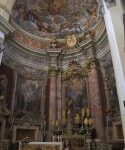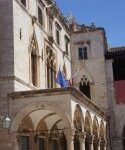July 31, 2013
Ragusa Revisited
If you’ve ever wanted a city where you could play dungeons and dragons, I think I’ve found it—the medieval city known as Ragusa, that since 1919 has been renamed Dubrovnik. Settled originally by Greeks from Epidavrus (where my class visited in May), the city became an independent republic in the 15th century, throwing off its Venetian masters after 200 years of Venetian rule; as an independent republic, it flourished as a shipbuilding center and a trader, assuming the role more or less of Switzerland as a neutral in a world at war. The gradual movement of trade from the Mediterranean to the Atlantic, and the shift from sail to steam reduced its renown, wealth, and power. Napoleon’s troops ended the republic with their capture of Ragusa in 1806, and the city came under the Austrian empire
until the emergence of the Kingdom of Yugoslavia.
 Lord Byron called it the “Pearl of the Adriatic,” largely because of the old city, which is circled by a 2 kilometer wall, built first in the 16th century, with towers, round towers, and a fairly intact baroque city rebuilt after a major earthquake in 1667. Glistening white in the summer sun of the Adriatic, it really does sparkle like a pearl.
Lord Byron called it the “Pearl of the Adriatic,” largely because of the old city, which is circled by a 2 kilometer wall, built first in the 16th century, with towers, round towers, and a fairly intact baroque city rebuilt after a major earthquake in 1667. Glistening white in the summer sun of the Adriatic, it really does sparkle like a pearl.
One of the main things to do here (the Lonely Planet pronounces it “likely your best memory”) is a walk around the wall, which at places is 80 feet high, from which you can overlook the city. But I’d done that last year, so I got to do things I’d run out of time to complete. Wandering around aimlessly is fun, because you stumble on things not in the guidebook—for 
 example, the clock tower, in true Mediterranean fashion, strikes the hour on the hour—and then six minutes later, giving latecomers a chance to be “on time.” The maritime museum is of above average importance, providing as it does a record of the history of shipping. The churches of the city have museums and treasuries with relics that remind one Ragusa was on the pilgrimage routes to the Holy Land from Europe, and visitors stopped here for water (one of the rebuilders in the late 18th century constructed an aqueduct to bring water from mountains miles away; the fountain still functions, and the cold, clear water is one of the few free attractions in the city!). Reliquaries with pieces of saints were revered in the
example, the clock tower, in true Mediterranean fashion, strikes the hour on the hour—and then six minutes later, giving latecomers a chance to be “on time.” The maritime museum is of above average importance, providing as it does a record of the history of shipping. The churches of the city have museums and treasuries with relics that remind one Ragusa was on the pilgrimage routes to the Holy Land from Europe, and visitors stopped here for water (one of the rebuilders in the late 18th century constructed an aqueduct to bring water from mountains miles away; the fountain still functions, and the cold, clear water is one of the few free attractions in the city!). Reliquaries with pieces of saints were revered in the 
 15th through the 17th centuries, and I saw silver shaped fingers or feet or hands or even a head holding bones of famous saints, such as Thomas Aquinas, and the local patron saint, Blaise, as well as a piece of the true cross.
15th through the 17th centuries, and I saw silver shaped fingers or feet or hands or even a head holding bones of famous saints, such as Thomas Aquinas, and the local patron saint, Blaise, as well as a piece of the true cross.
Wandering in the back streets, one comes across a baroque Jesuit church or a Dominican monastery, while the main street has a number of palaces, including one built for the “Rector,” who was elected to rule the city for one month, and had to stay in the palace during his term. One of the neatest is the customs house, which survived the earthquake and now houses a document museum.
 One of the best things I was able to do this time, though, was to take a cab with Carolyn up to the peak which overlooks the walled town, and to take pictures that resemble the postcards! Atop the hill—about 1200 feet above the harbor—was an old fort, built originally by Napoleon’s troops, as a defense measure against anyone attacking from the land side. The fort stood ready in 1991, when Yugoslavia split apart. Serbian forces, trying to reconquer the break away Croatia, invaded, and besieged Dubrovnik for over six months. A hastily organized Croatian force held the fort against the “so-called Jugoslav National Army” as the museum at Fort Imperial put it, although the city was shelled and cut off from the rest of Croatia. The Croatians had counted on the city’s status to protect it, but there was substantial damage to Dubrovnik, which was not really repaired until 2000.
One of the best things I was able to do this time, though, was to take a cab with Carolyn up to the peak which overlooks the walled town, and to take pictures that resemble the postcards! Atop the hill—about 1200 feet above the harbor—was an old fort, built originally by Napoleon’s troops, as a defense measure against anyone attacking from the land side. The fort stood ready in 1991, when Yugoslavia split apart. Serbian forces, trying to reconquer the break away Croatia, invaded, and besieged Dubrovnik for over six months. A hastily organized Croatian force held the fort against the “so-called Jugoslav National Army” as the museum at Fort Imperial put it, although the city was shelled and cut off from the rest of Croatia. The Croatians had counted on the city’s status to protect it, but there was substantial damage to Dubrovnik, which was not really repaired until 2000.
Today, however, it is a major tourist attraction,with one of the finest harbors on the Adriatic coast. 685 ships called last year, a guide told us, and 3 million visitors spent an overnight in the city. Seems like they were all here today!